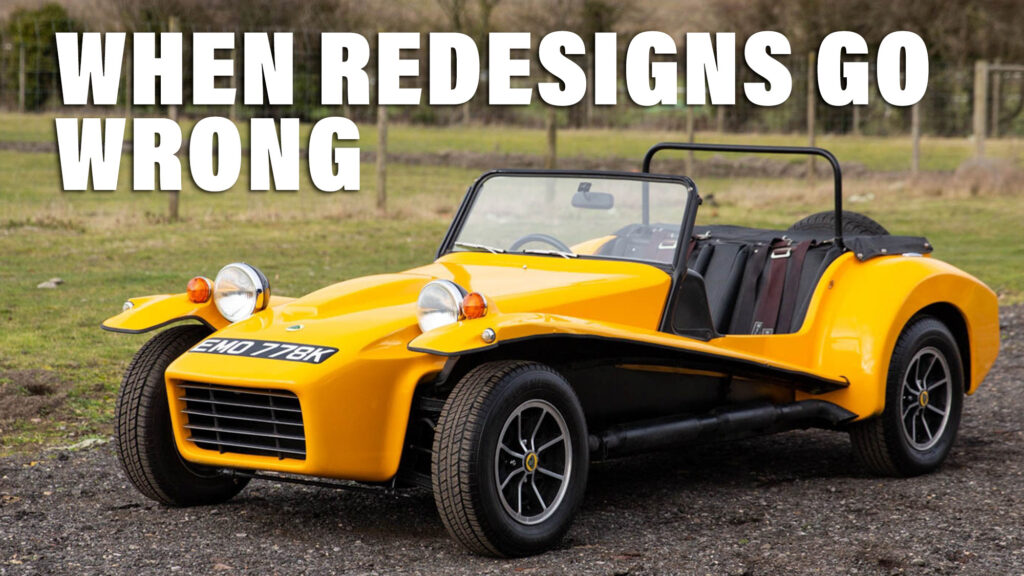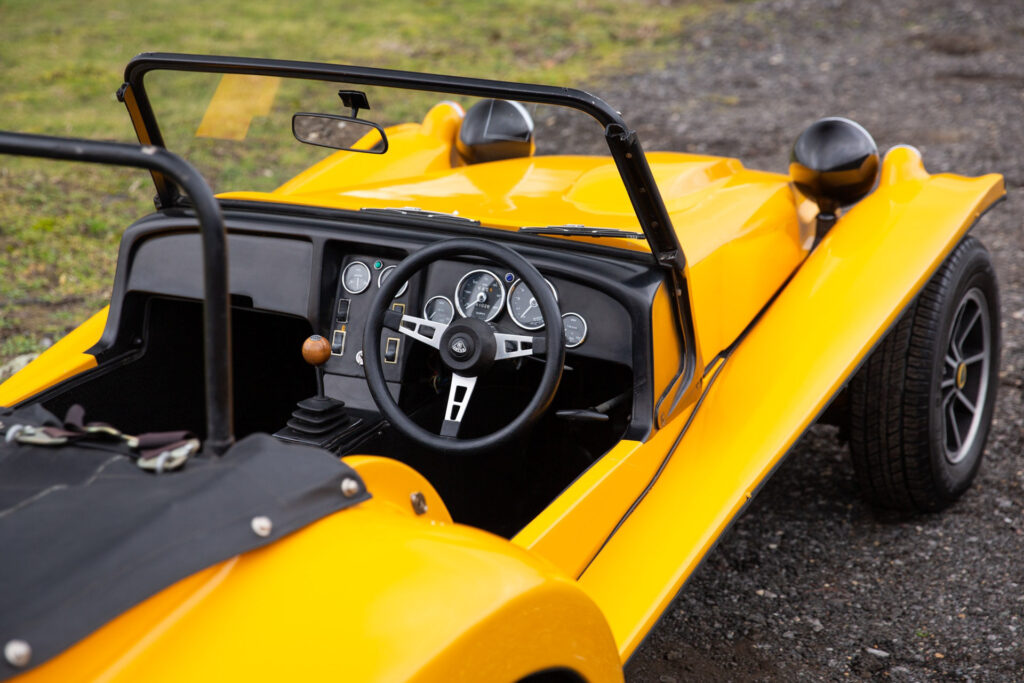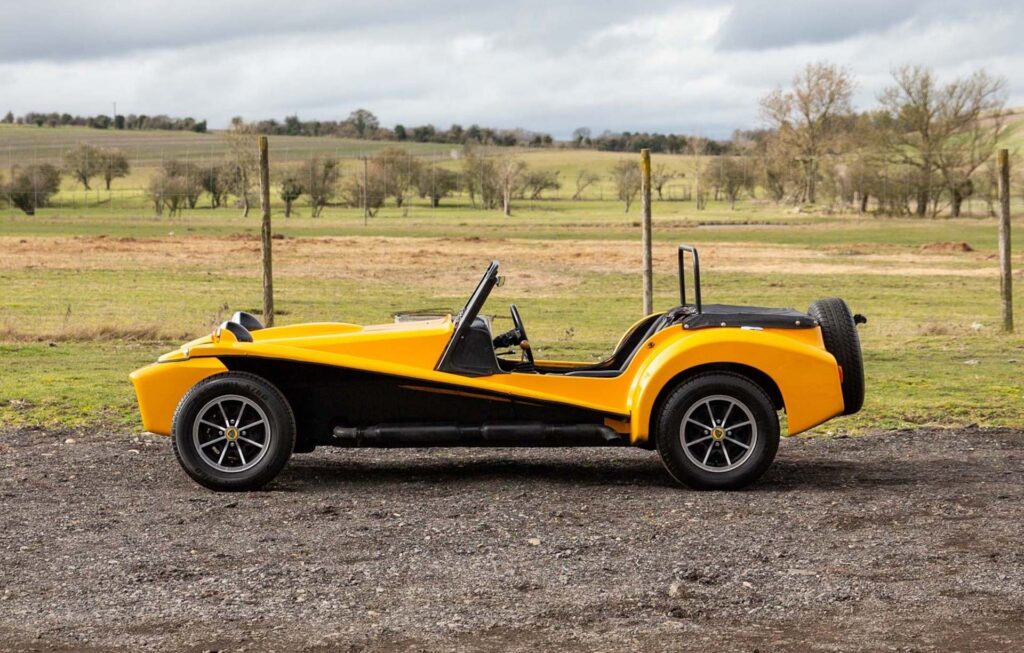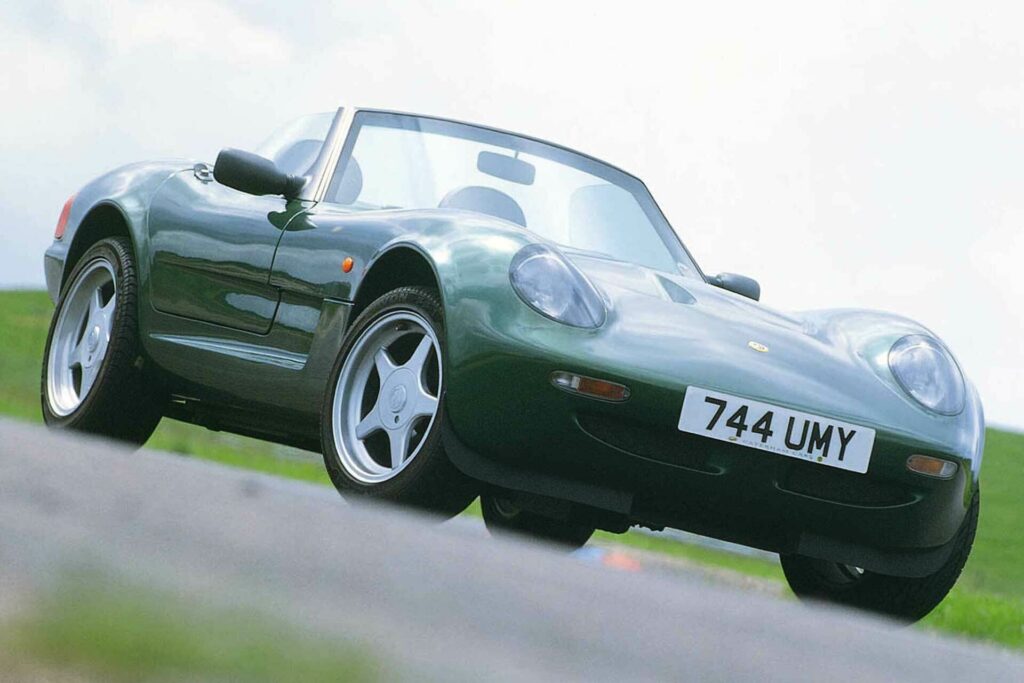The last Lotus version of the 7 swapped aluminium panels for longer, uglier fiberglass body
2 hours ago
 –>
–> 
by Chris Chilton
–>
This year marks the 50th anniversary of the Caterham Seven, as Lotus founder Colin Chapman sold the rights to the iconic sports car to Caterham’s Graham Nearn in May 1973. But the car Nearn inherited five months before the first oil crisis kicked off didn’t look like the anniversary Sevens Caterham will wheel out this year to commemorate the half-century celebration. It looked like the strange boxy yellow sports car you see here, the Seven S4, a failed and mostly forgotten attempt to update the iconic roller skate to compete with grown-up two-seaters from MG and Triumph.
It’s not difficult to see why Lotus wanted to facelift and ‘improve’ the Seven. The original dated back to 1957 when other affordable sports cars on the market like the MGA and Triumph TR2 weren’t that sophisticated either. They might have had doors, but they still made do with clip-on side curtains instead of windows.
But by the late 1960s, although the Seven’s performance had taken a giant step forward, jumping from as little as 40 hp (40 PS) to double that in ordinary versions, and more than three times as much in the rare Twin Cam cars, the basic package, together with the lack of refinement and interior space, was barely changed. And on top of that, Lotus was rumored to be losing £110 on each of the S3 cars it had introduced in August of 1968.
That S3 had ushered in a host of technical improvements suggested by Graham Nearn, who at that point was still several years away from owning the rights to the Seven, but was the sole distributor for the car, and had a fair bit of clout with Lotus as a result. Advances included fitting Ford’s new crossflow engines from the Cortina, the stronger, wider rear axle from the Ford Escort Mexico, and braking and suspension upgrades.
Related: The Caterham Super Seven 600 Proves That Double-Digit Power Figures Can Be Fun

A Seven For The Seventies
advertisement scroll to continue
But those important changes seemed minor compared with the ones that appeared just 18 months later on the Seven S4 at the 1970 Geneva Motor Show. The new car’s spaceframe chassis was longer, the rear axle gained Watts linkages for better location and stronger suspension arms, the double-wishbone front suspension was pinched from the mid-engined Europa and the old aluminum body panels had been swapped for an in-vogue fiberglass body more like the ones Lotus used on its other sports cars.
The extra 11.5 inches of overall length improved comfort for tall drivers, the car rode bumps better, the side screens now had sliding window elements, there were individual seats for the first time and you could even order a hardtop. Compared with an original Seven of a decade earlier it must have felt like a Rolls Royce. But compared with a Triumph Spitfire it still felt like a noisy, draughty racing car, and worse of all, to most eyes it was seriously ugly.
Designer Alan Barrett’s attempts to update the styling with a more contemporary, angular, feel while retaining the spirit of the previous Sevens was controversial, to say the least. It was also harder to repair because unlike the S3, which featured bolt-on panels, the majority of the S4’s body was molded as one.
The S4 wasn’t the total flop it’s sometimes accused of being. Lotus sold 664 in less than three years, but then it had hoped to move 2,000 every year. And Chapman was already confident that Lotus was going to miss that target by a mile when he decided in the summer of 1971 to bring the axe down, though the car lived on for another year and a bit while the company used up its parts supply. Chapman was looking forwards and upwards and the archaic money-losing Seven didn’t have a place in the future of Lotus Cars.
[embedded content]
Caterham Comes To The Rescue
That could have been the end of the Seven if it hadn’t been for Graham Nearn. He stepped up from distributor to manufacturer in May 1973 when he agreed to a deal with Chapman to buy the rights to the Seven, putting the sports car back on sale that year. The Seven S4, that is. Though lacking a Lotus badge, Caterham’s Seven was pretty much identical to the one Lotus had been selling before canning the car. But that was about to change.
The S4 was complicated and expensive to build for a small outfit like Caterham with some parts suppliers demanding big orders that Britain’s newest carmaker couldn’t entertain. So after selling just 38 S4s, Caterham switched back to the metal-bodied S3 Lotus had launched in 1968. And though the firm has introduced thousands of upgrades since, including a semi-independent de-Dion axle in 1985 and dozens of engine permutations, today’s cars can still trace their DNA to that S3.
So it’s little wonder that the S4, on sale for just over two years, tends to get forgotten about, or seen as a Seven dead-end. Values bear that out: Hagerty’s UK price guide says you’ll pay £40,400 ($48,500) for a Lotus-built Seven S3 in show condition, but just £23,700 ($28,500) for an S4 with the same engine and in the same fine fettle.

Related: Caterham Is Planning A Lightweight, All-Electric Two-Seater
But, if you look at it another way, that means the S4, a rare and fascinating chapter in the Seven story, is actually a bit of a bargain. And though most people would agree it’s not as easy on the eye as the earlier and later cars, much like BMC’s square-fronted Mini Clubman introduced around the same time, the S4 looks kind of cool when taken in context of what was going on in the car world when it was designed, and what Lotus was trying to achieve.
Which leads us on to the eye-popping 1971 S4 in these pictures. Currently listed on the Collecting Cars auction site, it’s impossible to miss thanks to that Lotus Deep Yellow paint and appears to be in good condition, though the description refers to a few chips and some cracks and crazing in the fiberglass body, and some minor interior wear.
The hottest S4s got Lotus’s 1.6-liter twin-cam that was good for either 115 hp (117 PS) or 125 hp (127 PS), but both were rare. Most came with a 1.3-liter Ford crossflow putting out 72 hp (73 PS), or the 85 hp (86 PS) 1.6 that this car was ordered with. This example’s engine has been treated to a ‘fast road’ rebuild that includes a modded head from respected classic Ford tuner Burton, however, so it’s probably a little healthier than that. If you’re interested, the auction ends on March 13.

Or you could hunt out Caterham’s own, equally unsuccessful attempt to update the Seven. That’s right, despite seeing the error of Lotus’s ways and reverting to the S3 format in 1974, Caterham tried its own hand at a more modern, more refined Seven-based sports car in 1994, clothing a seven chassis in a radically different close-wheel body and christening the result ’21’ in reference to the number of years that had passed since the company had acquired the rights from Lotus. Sadly for Caterham, by the mid-1990s Lotus had developed its own truly modern successor to the Seven, the Elise, and the pretty 21 sank without trace having found only 49 homes, making even the Seven S4 look like a sales smash.
 –>
–> 
